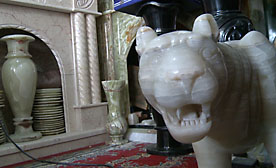Afghanistan's heart of marble
Over the last decade, NATO and the international community have strived to improve security and stability in Afghanistan. Better conditions have led to an increase in business opportunities for the Afghan people and the country’s economy is growing. The export of marble is one of the new industries contributing to this growth. According to mining experts, 700 million dollars worth of marble stone lies untapped across Afghanistan.

Adam Doost has worked in Afghanistan's marble sector since 2006. He says in six years 32 factories have been opened in Herat province, creating almost 4000 jobs.
Most of the marble produced in Herat goes to the domestic market or to Pakistan, but samples shipped abroad are making their mark.
“Our customers are in Italy, India, China, Turkmenistan and Turkey,” says Doost.

Afghan marble has often been compared to the first class Italian white marble of Carrara and that has attracted a lot of interest from Italian buyers in the past year.
As with much industry in Afghanistan, lack of security and poor transport infrastructure prevent Afghan companies from being competitive. So Afghans prefer to buy Iranian or Pakistani marble, which is much cheaper on the market.
Marble dealers say the Afghan government should support domestic products by providing facilities required by Afghan traders and also by reducing the royalty payments that marble quarries are forced to pay.
“In Afghanistan everything is more expensive: electricity; labour. Production is low and that's why the price of Afghan marble is more expensive compared to Pakistani marble,” says Shafiq Ahmad, who owns a marble shop in Kabul's bazaar.
Afghan marble entrepreneurs remain confident foreign investment will soon transform marble production into one of the most lucrative industries in Afghanistan.
“Marble has a global market,” says Ahmad. He adds, “We use only Afghan marble and its quality is the best in the world.”
